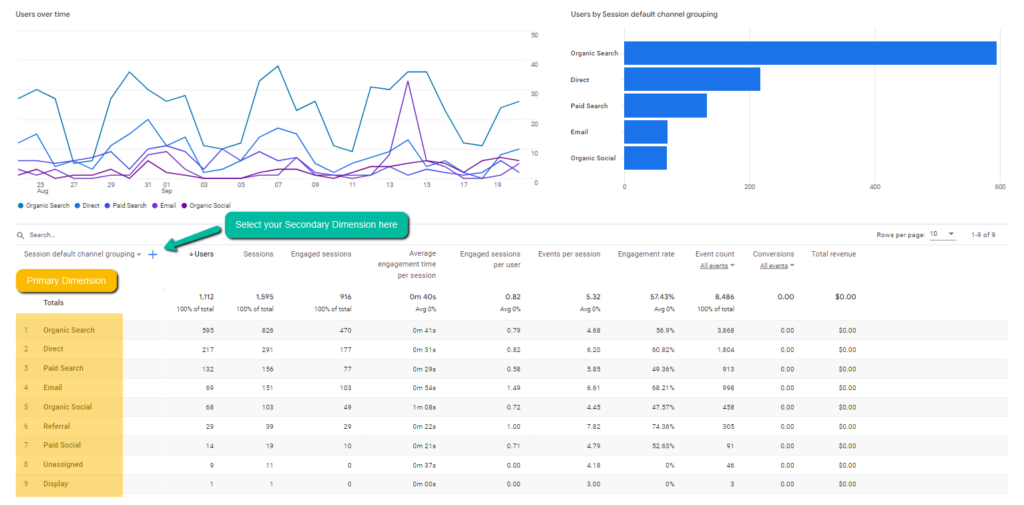Enhance Your Reporting with Secondary Dimension in Google Analytics
Enhance Your Reporting with Secondary Dimension in Google Analytics
Blog Article
Unlock Deeper Insights With Second Dimension in Google Analytics
With the substantial stretch of information readily available in Google Analytics, the application of secondary dimensions can considerably enrich your logical capacities. These extra layers of information provide a nuanced perspective that can light up intricate details within your primary metrics. By purposefully integrating second measurements into your evaluation, you can unearth valuable understandings that might or else continue to be undiscovered. The capacity to interpret and divide customer actions with greater accuracy opens a world of possibilities for improving and maximizing strategies efficiency.
Understanding Primary Vs. Additional Dimensions
On the other hand, second dimensions permit you to additional explore your key dimension information. By adding a second measurement, you can layer on extra details to your key dimension, making it possible for an extra granular analysis. If your main measurement is the source/medium through which individuals showed up on your site, adding an additional measurement like geographic area can disclose where those customers are situated geographically.
Using Second Measurements Properly
Effectively utilizing additional measurements in Google Analytics enhances the deepness and granularity of data analysis, offering useful understandings into customer behavior and patterns. By incorporating second dimensions alongside main dimensions, marketing professionals and analysts can delve much deeper into the specifics of customer interactions on their sites. Second dimensions enable individuals to section and filter primary measurement data additionally, offering a more thorough sight of user communications, actions, and demographics. This can be specifically useful when trying to comprehend the influence of details variables on individual involvement, such as the devices or web browsers they are using, the sources of their website traffic, or their geographic places.
Moreover, second dimensions allow users to contrast and contrast various information factors within a solitary report, promoting a much more extensive analysis of individual habits patterns. By leveraging additional dimensions successfully, organizations can reveal hidden insights, optimize their marketing strategies, and improve the total individual experience on their web sites.
Discovering Typical Second Dimension Combinations
To better examine individual behavior and trends in Google Analytics, it is valuable to check out common mixes of second measurements. By combining different secondary dimensions, marketing professionals and analysts can gain deeper insights into just how various elements interact and influence internet site efficiency. Some usual additional measurement mixes that offer beneficial understandings consist of assessing website traffic resources with user locations to comprehend where website visitors are coming from geographically and exactly how they located the site. Incorporating landing pages with tools can disclose which pages perform best on various devices, aiding in enhancing the site for better individual experience. Examining user actions metrics with additional measurements such as demographics or passions can aid in targeting particular audience sections more properly. By checking out these common additional measurement mixes, companies can reveal hidden patterns, recognize chances for improvement, and make data-driven choices to improve their on-line presence.
Using Secondary Dimension in Customized Reports
Using secondary dimensions in custom records allows for an extra extensive analysis of information in Google Analytics, enhancing the depth of insights acquired. When producing custom-made reports in Google Analytics, incorporating second dimensions can provide a more comprehensive view of how different dimensions connect with each various other. This feature makes it possible for individuals to delve deeper right into their information and uncover useful relationships that may not be right away obvious.
By using second dimensions in customized reports, customers can obtain a much better understanding of their web site or app web traffic. For instance, incorporating the primary measurement of "source/medium" with the additional dimension of "landing page" can reveal which landing pages are additional info doing ideal for website traffic coming from details resources. This understanding can aid marketing experts optimize their campaigns and boost overall conversion rates.

Enhancing Information Visualization With Additional Dimension
When checking out information in Google Analytics custom-made reports, including additional dimensions not only supplies an extra thorough evaluation but additionally enhances the graph of understandings with data visualization. By adding an additional measurement to your reports, you can enrich the method information is provided, making it easier to recognize patterns, patterns, and relationships within your internet site's efficiency metrics.
Additional measurements can help you sector your information better, allowing for a much deeper understanding of user actions and communications on your site. This enhanced degree of granularity can be specifically helpful when trying to separate certain variables that might affect your internet site's performance - Secondary Dimension in Google Analytics.

Verdict
In conclusion, leveraging second dimensions in Google Analytics permits an extra thorough evaluation of information, bring about deeper understandings and even more enlightened decision-making. Secondary Dimension in Google Analytics. By adding added layers of information to main data collections, online marketers and experts can uncover surprise trends, patterns, and connections that give a granular view of customer behavior and communications. This boosted level of insight enables optimization of campaigns and customized approaches for specific audience segments, ultimately enhancing performance and conversion rates
On the various other hand, secondary dimensions enable you to further dissect your key measurement data. By including a second measurement, you can layer on additional info to your main dimension, making it possible for a more granular analysis. If your main measurement is the source/medium through which users showed up on your site, including a second dimension like geographic location can disclose where those individuals are situated geographically. By incorporating second dimensions alongside primary measurements, experts and marketing professionals can dig deeper into the specifics of customer interactions on their websites. Secondary dimensions allow users to segment and filter main dimension information additionally, using a more thorough sight of user demographics, communications, and habits.
Report this page